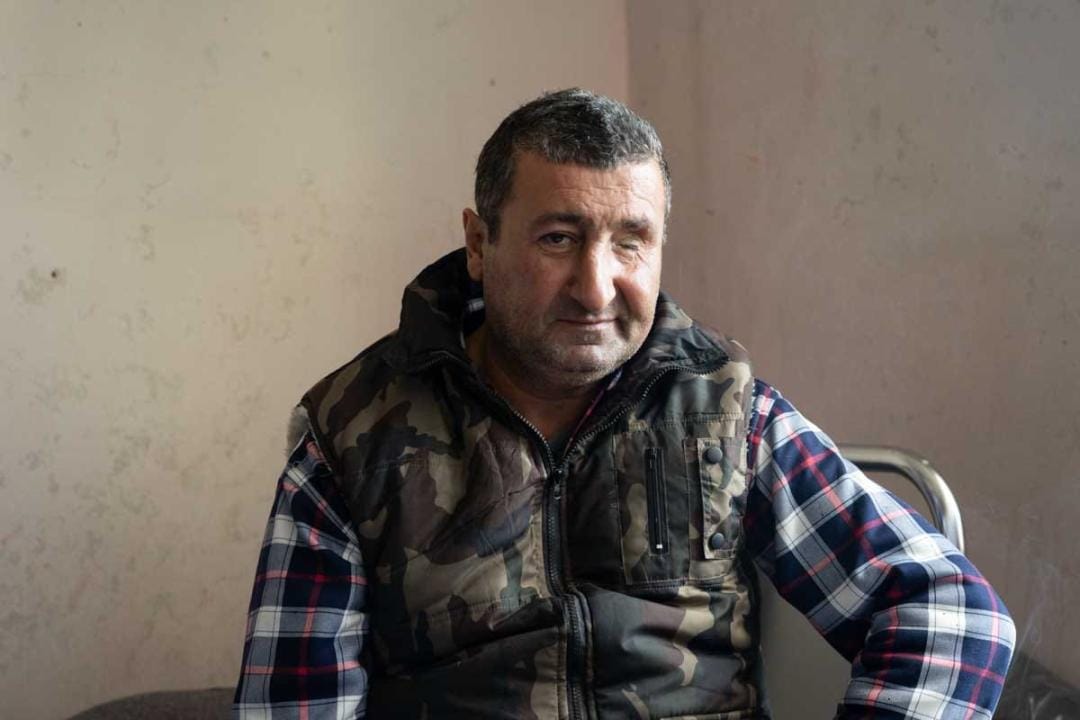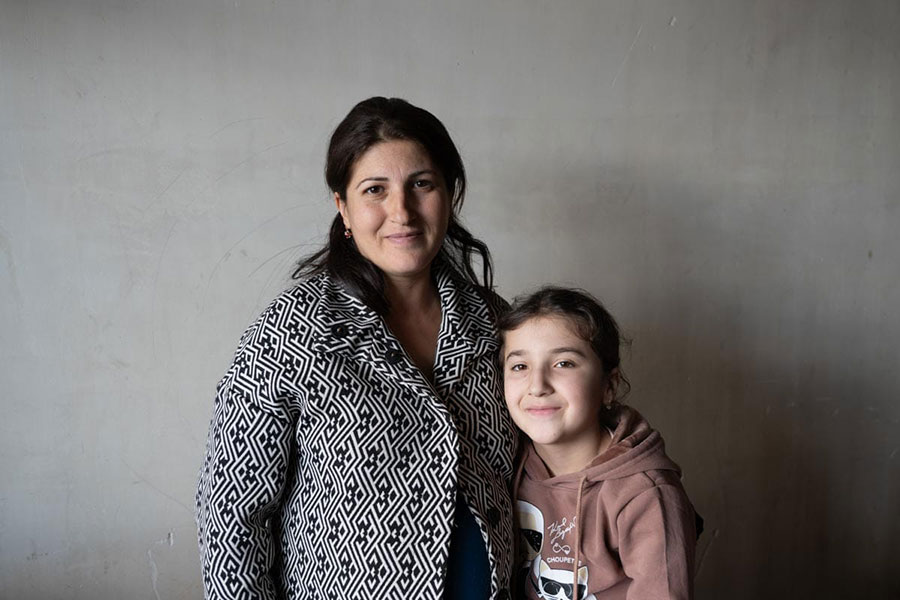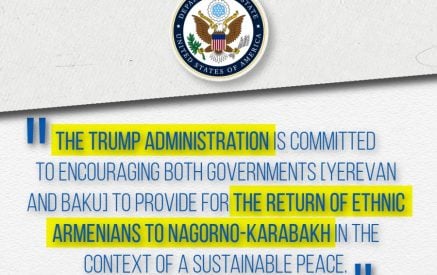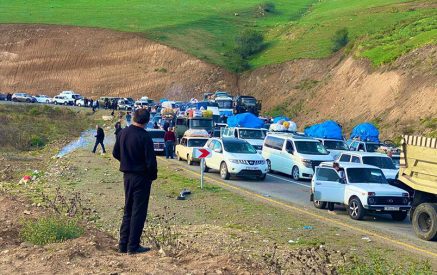Armenia is having problems integrating over 100,000 refugees who fled Nagorno-Karabakh when Azerbaijan took control of the enclave in September 2023. Yerevan has tried to be generous, but it lacks funds and a long-term plan, leaving the displaced people exposed and facing an uncertain future.
Lusine had intended to raise her fourth child in the large, comfortable home that her family built over ten years in Nagorno-Karabakh, a mountain enclave in Azerbaijan. Since the early 1990s, ethnic Armenians had controlled the area, in defiance of Baku, but in September 2023 that de facto autonomy came to an end – and Lusine’s plans along with it. When Azerbaijani troops rolled in, she quickly gathered her family and packed up everything she could carry, fleeing along with 100,000 others to seek refuge in Armenia. January found her in a teeth-chatteringly cold, half-built house lent to her by local Armenian authorities.
Read also

(Above) Lusine and her family members inside the house where all twenty of them now live. (Below) The exterior of the house, with the truck they arrived in parked out front. November 2023. Astrig Agopian for CRISIS GROUP
Azerbaijan’s offensive on 19 September led to the exodus of almost the entire population of Nagorno-Karabakh in just a few days. The pregnant 34-year-old Lusine travelled with her children in the bed of an old construction truck. The attack had been preceded by a nine-month Azerbaijani blockade of the region that left residents undernourished, lacking medical supplies and deeply distressed. As Azerbaijani troops advanced, the de facto authorities, who had governed the region with Armenia’s support since seizing it from Azerbaijan in the 1990s, quickly surrendered. Thus ended a long, violent struggle for control of Nagorno-Karabakh that fuelled three wars in as many decades and left a legacy of mass displacement of both ethnic Armenians and Azerbaijanis.
Like other refugees, Lusine and her twenty relatives sheltering in the sparsely furnished and unpainted dwelling they now call home are too fearful to return even if they could. While a few refugees from the enclave have moved on to Russia or Europe, making a new life in Armenia is the only option for most. Lusine’s new neighbours gave them some old beds and a wobbly table; charities provided food and clothing; and the family has installed a wood stove in one room. “It is still cold, and the wood is so expensive”, Lusine said. “We had to leave in one day. And now we have nothing. What will be our future?”
A similar question faces the Armenian government. It has pledged to fully integrate Karabakh refugees – whose plight has evoked sympathy among the Armenian citizenry – but the resource and planning challenges that lie ahead are substantial.

Lusine’s family members inside the house they all share, November 2023. Astrig Agopian for CRISIS GROUP
A Generous Start
By most accounts, Armenia has been as generous as its resources allow with Nagorno-Karabakh’s former residents. The government registered arriving refugees and helped them find shelter in population centres rather than guiding them into refugee camps. All are eligible for Armenian citizenship, of which some have already availed themselves. Every adult has received a one-off payment of $250, followed by a $185 monthly stipend – the minimum wage in Armenia where people on average earned $668 per month in 2023 – to cover rent and basic needs. In towns throughout the country, refugees have been getting by on this support, stretching it by banding together to live with several people under one roof. But the aid has strained the state budget, and it is not clear how long Yerevan can sustain the payments. It is a huge burden for a country of some three million people, a quarter of whom were already living below the official poverty line. At least one in every 30 people now living in Armenia is a refugee from Nagorno-Karabakh – as many as the inhabitants of the country’s second-largest city, Gyumri.
Unless the government gets more funds to help it cover refugee-related costs, poverty and social frictions look set to mount. “You will start seeing real problems in three to four weeks if the government starts lacking money to cover the bills”, said an international expert who came to Armenia in the wake of the crisis, warning of a surge in homelessness. Armenians’ solidarity with refugees has been remarkable to date, but fatigue could kick in. Resentment may take root among locals if they see refugees being helped into jobs and housing that others might struggle to find, or bringing down wages, local officials and international experts said. Inadequate support for refugees now could lead to even costlier long-term social problems. “The local government would have to hire more social workers”, the head of an international humanitarian organisation said. “The same is true for police, doctors and teachers”.
Yerevan has sought international aid, but the amounts received have been insufficient. The European Union pledged over €17 million ($18 million) in budgetary support for Armenia’s cash payments to refugees, but disbursement of the funds has been delayed, seemingly by bureaucratic hurdles. International and local organisations, including UN agencies and the International Committee of the Red Cross, have also provided humanitarian support, but they say they are having trouble raising funds so that they can give more. In October 2023, the UN High Commissioner for Refugees (UNHCR) estimated that the government would need $97 million to cover refugees’ essential needs through the end of March. Together, 60 international and local organisations have collected 47 per cent of this amount (which is separate from the EU’s pledge). To bridge the gap, Armenia has taken out a loan from the World Bank, and it is sounding out other international lenders as well. Armenian diaspora organisations from Europe and the U.S. are preparing to help the government organise a conference to raise additional funds from states and private donors, but no date has yet been set.
To the extent Yerevan seeks funding for more than cash assistance and humanitarian aid, however, it will need to make clear what precisely it is asking donors to support. Since October, the government has been working on coordinating several programs to support longer-term integration, but it has announced no overall plan and offered no cost estimate.
Making Housing a Focus
The government says housing will be the main focus of its efforts. In September, as Karabakh residents flowed into Armenia, it moved fast to register and dispatch them to parts of the country where local authorities had housing available. But the vast majority of refugees gravitated toward the capital, despite the higher rents, thinking it would be easier to find work there. Almost half settled in Yerevan and another 30 per cent in the vicinity, where local authorities say there are far more refugees than available housing. In the town of Masis, a twenty-minute drive from the capital, many local officials had to temporarily vacate their offices so that refugees could move in. Kindergartens, libraries and schools have been repurposed as living spaces. Locals estimate that 11,500 people – almost 10 per cent of Nagorno-Karabakh’s previous Armenian population – have arrived in Masis, nearly doubling the number of residents. The former de facto Republic of Nagorno-Karabakh flag now flies beside Armenia’s over the town hall.
The Armenian government will eventually have to find places for these refugees in temporary housing to go to. Many, like Lusine and her family, have found shelter in unfinished or abandoned houses – some the vestiges of households who left the country for economic reasons. Many still have legal owners. “Some may agree to sell, but some may not”, said a municipality leader. He and officials in other regions said they were talking to private companies and wealthy individuals about donations to build new housing. In Kotayk, a central region north of Yerevan, they estimated the cost to be at least $20,000 per family to build a small house near the main town.
There are cheaper options in sparsely populated regions – though few refugees want them. Vardenis, which borders Azerbaijan, is cheapest of all, with a village house ready to move into going for some $5,000. But one reason the prices are low is that, over the past three years, it has become the most dangerous area along the border, with frequent skirmishes between the Armenian and Azerbaijani militaries. Many residents have already left, and many more are eager to sell their homes and relocate. Among people from Nagorno-Karabakh, still suffering from the trauma of forced displacement, Vardenis is hardly a draw. “Refugees would get off the buses halfway when they learned the government was sending them to Vardenis”, said a town official. “No one wanted to live at gunpoint again”. Some 800 Karabakh Armenians have arrived in the region, only a tenth of the number local officials had made plans for. “These are the poorest, who had no choice”, a humanitarian worker said.
State housing policy is set to change in March, with rent subsidies shrinking in favour of longer-term support for buying or building homes. In the coming weeks, the government is planning to offer around $7,400 per person to each family with more than two children to buy or build a house. The aim is for refugees to put down roots in one place, an official said. It remains unclear what other subsidies the other refugees will continue receiving and for how much longer. While the new policy may help refugees find more stable and sustainable housing solutions, municipal leaders are steeling themselves for a new crisis if rent support dwindles.
The Employment Challenge
As concerns employment, the government and civil society made quick first moves. In January, Yerevan began a special support project offering to reimburse companies paying refugee salaries for a certain period, in the hope that the firms would extend this arrangement into longer regular contracts. Over 5,000 Karabakh Armenians started working in their first six months in Armenia, official data shows. “The main question is how many will retain these jobs”, an Armenian businessman said. “I bet the numbers will be small”. Some locals organised job fairs for Karabakh Armenians. At one of these events, held at Yerevan’s main university, company representatives met with a group of job seekers, predominantly men – a scene consistent with the gender employment gap among this population. Tigran, a taxi company representative, brandished a list of over twenty refugees he had interviewed for drivers’ jobs. The bespectacled 21-year-old, who himself fled Nagorno-Karabakh in September, has been managing cab drivers for several weeks. “The main thing is to stop thinking we are refugees”, he said. “Armenia is not foreign to us. We must start a new life here”.
But it will be a long road for all the displaced people who want jobs to find them. At best, it will take an estimated ten to twenty years, according to an independent economists’ report for the government that Crisis Group has seen. That could undo some of the progress Armenia has made in tackling joblessness as the economy has grown in the past five years, raising unemployment from its current level of 11 per cent to 15-17 per cent. The above-referenced report calls for an ambitious plan to create up to 25,000 new jobs and reskill up to 4,000 people in sectors such as manufacturing, agriculture, construction and retail. Without these measures, it suggests, thousands of displaced families may be compelled to flee once again. (Russia is a major destination for Armenian workers who send remittances home and over 6,400 people from Karabakh have already moved there, Armenian officials say.)
Some foreign development experts agree on the need to think big. They have recommended to the government tax breaks and special projects to attract job-generating investments in construction and infrastructure. A Western development agency representative suggested that Armenian diaspora groups in the West could act as liaisons to get major U.S. and European construction and other companies to establish offices in those Armenian regions hosting significant refugee populations. In the past, successful Armenian émigrés have invested in Armenia, helping generate jobs and provide communities an economic boost, especially in places distant from the capital. The government should look for ways to collaborate again with the diaspora in support of the new wave of refugees.
Supporting the Most Vulnerable
Not all the Karabakh refugees will be able to work. The new arrivals include 30,000 children and 18,000 people aged over 65, according to the UNHCR. There are also several thousand disabled people. Men with missing limbs, from war injuries and landmine explosions, are a not-infrequent sight in areas where Karabakh refugees have moved. Stepan, 49, sleeps on an iron bed in the corridor of a kindergarten, where renovations were halted to accommodate dozens of refugees. He lost his right hand and left eye during the first war over Nagorno-Karabakh in the early 1990s but nevertheless cares for an elderly aunt. They get by on his wife’s meagre salary from a cleaning job at a school, but they have received a notice telling them to vacate the kindergarten in March. “I don’t want to think about the future”, Stepan said. “We have nowhere to go. Here, I am nobody. Who will help us?”

Stepan, 49, lost his arm and an eye during the first war in Nagorno-Karabakh. Now, he lives with his family in the corridor of the kindergarten in Masis, November 2023. Astrig Agopian for CRISIS GROUP
Armenia should expand existing support programs to ensure that disabled people have the support that they require. Armenian non-governmental organisations say around 9,000 people with disabilities lived in Nagorno-Karabakh before the 2020 war, but only about 2,000 had officially registered as persons with disabilities upon arrival in Armenia. State institutions caring for elderly and disabled people have seen a 25 per cent rise in residents since the refugee crisis, said Mushegh Hovsepyan, who heads an NGO called Disability Rights Agenda. Arpenik, 84, is waiting for a spot in one such care facility. At first, she stayed back when people began fleeing Nagorno-Karabakh. “I got worried when I stopped hearing even the sounds of dogs barking”, she said. She stopped a passing Azerbaijani police car, which took her to the Armenian border, where she found temporary housing. “I’ve lived such a long life, all of it in one place”, Arpenik said. “If only I could have a bit more certainty about where I will spend the last days of my life”. The Council of Europe’s Human Rights Commissioner has urged Armenia to accelerate reforms that will help people with special needs to stay at home rather than move into institutions where possible.
People who feel stigmatised by their special needs in light of prevalent social norms – such as those with HIV or drug addiction – face even greater challenges. Armenian NGOs spent over a month tracking down over 100 people among displaced Karabakh Armenians, who were previously in databases to receive HIV medications. Even then, some placed in sports halls and other collective centres refused treatment, fearing their neighbours would find out and make them outcasts, said Zhenya Mailyan, head of the NGO Real World, Real People. For drug addicts, she said, Armenia runs a special treatment program, but it is available for free to only a handful – around 600 people – and getting help of any kind outside Yerevan is almost impossible.
The Need for a Plan
Armenia absorbed a wave of refugees from the Karabakh fighting in 2020, but this challenge is far bigger. As it struggles to pull together the strands of an integration plan, Yerevan is under pressure – not only from Karabakh Armenians, who wonder what the future holds for them, but also from the citizenry and potential donors. A fully articulated plan must address housing and employment, make full partners of local authorities who will be implementing its directives, and consider the impact that it will have on the locales where it will be put into practice. In some places, bolstering service providers such as schools, police and hospitals can help meet the needs of recently arrived refugees, but well-designed programs would seek to boost support to entire communities – not just new arrivals.
Meanwhile, refugees like Lusine, grappling with their recent loss, are still coming to grips with a new and challenging reality. Her husband recently found a job building roads – albeit in another region of Armenia. “The kids still occasionally see our house in Askeran in their dreams”, Lusine said. “It will take years, probably decades, until we start living a normal life again”.

























































